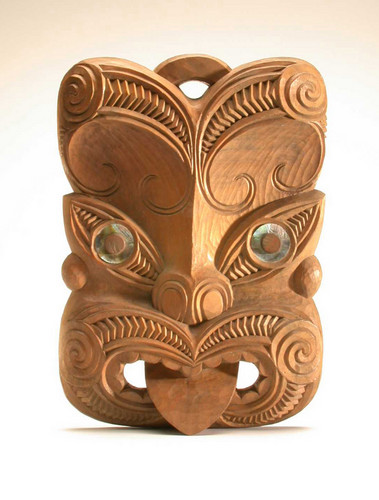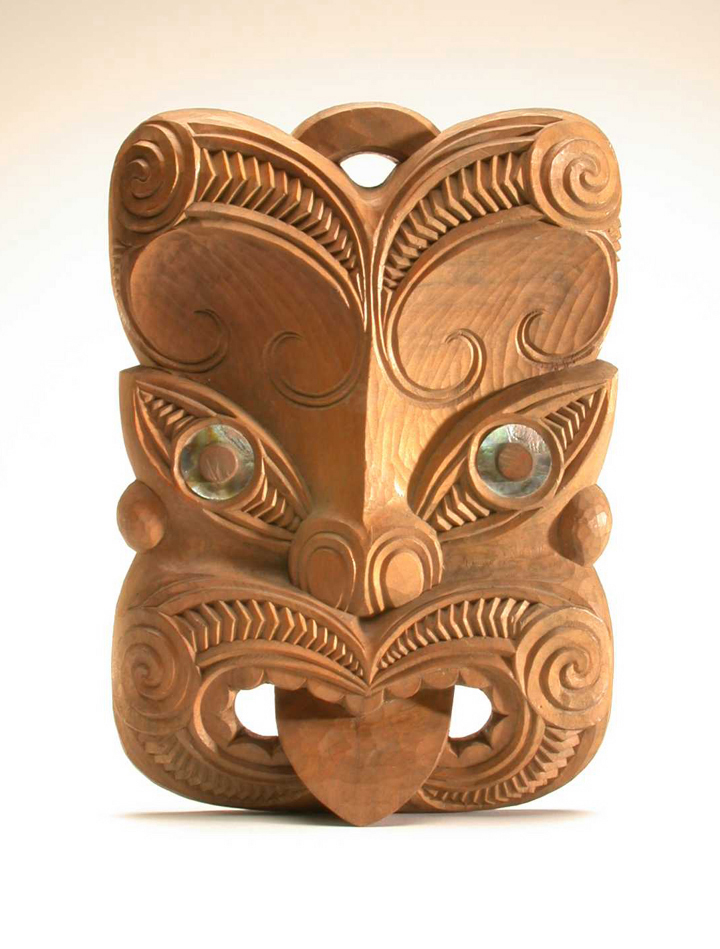Maori Mask, New Zealand
Maoris, the original people of New Zealand, honour their ancestors. This woodcarving is of an ancestor and would have been found on a Maori meeting house.
The mask looks very fierce - the mouth is open, with the tongue sticking out and the eyes protruding. The expression is aggressive and looks like the grimaces that Maoris make during war dances.
The lines on this mask mirror Maori tattoos, which, traditionally they had on their faces to make them look fierce, and so scare off their enemies. Today some Maori people are reviving this tradition as they try to preserve their culture and identity.
This mask is carved from one piece of light softwood. At the back and top of the mask the initials RIKI are carved into the wood, and this is probably the name of the person who made it.
The mask looks very fierce - the mouth is open, with the tongue sticking out and the eyes protruding. The expression is aggressive and looks like the grimaces that Maoris make during war dances.
The lines on this mask mirror Maori tattoos, which, traditionally they had on their faces to make them look fierce, and so scare off their enemies. Today some Maori people are reviving this tradition as they try to preserve their culture and identity.
This mask is carved from one piece of light softwood. At the back and top of the mask the initials RIKI are carved into the wood, and this is probably the name of the person who made it.

Height:50cm
The Maoris (pronounced mar-e) are the aboriginal people of New Zealand. They arrived there in the 13th century. Their culture is based on living in tribes, on hunting and gathering food, and on warfare. They are skilled in tattooing and woodcarving and their elaborate woodcarvings decorate canoes and buildings. Their pendants and ornaments are carved from bone or stone.
This woodcarving would probably be on a post or panel of the Maori meeting house. The house (whare runanga) represents the common ancestor and each part of the house represents different parts of the ancestor. The mask (koruru) is the head of the ancestor and sits on top of the ridge pole (the backbone). The porch is the ancestor's brain and the inside of the house is the ancestor's belly. The rafters and wall slabs are the ancestor's ribs. The ancestral meeting house welcomes all Maori people, and weddings, christenings, birthdays, family reunions, tribal meetings and funerals take place there.
The main symbols of Maori carving are an ancestor or god, and the other is a bird. Maoris also carve the sea monster, the whale and the lizard. Each tribe has its own style of carving. This woodcarving comes from one of the eastern tribes. It is square in shape and has slanted brows, wheku.
Maori woodcarving is now flourishing and there is a New Zealand Maori Arts and Crafts Institute, which provides training and promotes this craft.
The Maoris believe in concepts such as taboo, life force (mauri), revenge, the prestige of a social group or individual and sorcery. They have faith in number of gods - Tane-mahuta - lord of the forest, Tangaroa - an ocean god, and Io the supreme god. Spirits are also seen as powerful beings; they have the ability to respond to magical spells and punish people for breaking taboos.
Some of the Maori traditions are: pressing noses in greeting 'hongi'; full facial tattoos 'moko'; cooking in the earth on hot stones 'hangi'; and performing a war dance before battle 'haka'. These days haka is performed by New Zealand's rugby team, the All Blacks, as they try to strike fear into the hearts of their opponents at the beginning of rugby matches.
This woodcarving would probably be on a post or panel of the Maori meeting house. The house (whare runanga) represents the common ancestor and each part of the house represents different parts of the ancestor. The mask (koruru) is the head of the ancestor and sits on top of the ridge pole (the backbone). The porch is the ancestor's brain and the inside of the house is the ancestor's belly. The rafters and wall slabs are the ancestor's ribs. The ancestral meeting house welcomes all Maori people, and weddings, christenings, birthdays, family reunions, tribal meetings and funerals take place there.
The main symbols of Maori carving are an ancestor or god, and the other is a bird. Maoris also carve the sea monster, the whale and the lizard. Each tribe has its own style of carving. This woodcarving comes from one of the eastern tribes. It is square in shape and has slanted brows, wheku.
Maori woodcarving is now flourishing and there is a New Zealand Maori Arts and Crafts Institute, which provides training and promotes this craft.
The Maoris believe in concepts such as taboo, life force (mauri), revenge, the prestige of a social group or individual and sorcery. They have faith in number of gods - Tane-mahuta - lord of the forest, Tangaroa - an ocean god, and Io the supreme god. Spirits are also seen as powerful beings; they have the ability to respond to magical spells and punish people for breaking taboos.
Some of the Maori traditions are: pressing noses in greeting 'hongi'; full facial tattoos 'moko'; cooking in the earth on hot stones 'hangi'; and performing a war dance before battle 'haka'. These days haka is performed by New Zealand's rugby team, the All Blacks, as they try to strike fear into the hearts of their opponents at the beginning of rugby matches.

Height:50cm

Maoris, the original people of New Zealand, honour their ancestors. This woodcarving is of an ancestor and would have been found on a Maori meeting house.
The mask looks very fierce - the mouth is open, with the tongue sticking out and the eyes protruding. The expression is aggressive and looks like the grimaces that Maoris make during war dances.
The lines on this mask mirror Maori tattoos, which, traditionally they had on their faces to make them look fierce, and so scare off their enemies. Today some Maori people are reviving this tradition as they try to preserve their culture and identity.
This mask is carved from one piece of light softwood. At the back and top of the mask the initials RIKI are carved into the wood, and this is probably the name of the person who made it.
The mask looks very fierce - the mouth is open, with the tongue sticking out and the eyes protruding. The expression is aggressive and looks like the grimaces that Maoris make during war dances.
The lines on this mask mirror Maori tattoos, which, traditionally they had on their faces to make them look fierce, and so scare off their enemies. Today some Maori people are reviving this tradition as they try to preserve their culture and identity.
This mask is carved from one piece of light softwood. At the back and top of the mask the initials RIKI are carved into the wood, and this is probably the name of the person who made it.
- Term:
- Description:
- All Blacks
- The New Zealand rugby team.
- Ancestor
- Ancestor worship - the worship of dead ancestors where people believe that the spirits of the dead can influence their affairs. Ancestral spirits can be male or female, and can include all ancestors, those of a few generations, or indeed mythical ancestors. People worship their ancestors in many ways, such as prayers, offerings, sacrifice, and festivals of honour. Ancestor worship is found in many African traditional religions, where the spirits are called on to avert illness, help obtain good crops, or assure fertility.
- Hangi
- A Maori tradition where food is cooked on hot stones, on the earth.
- Hongi
- A Maori greeting where people press noses instead of kissing.
- Maori
- A nation of people who settled in New Zealand around the 13th century.
- Moko
- Full facial tattoos worn by Maori men. Women do not usually have full facial tattoos - their tattoos are on the chin area, upper lip and nostrils only.
- Tattoos
- Pictures or designs made on someone's body by pricking small holes in the skin and filling them with a indelible dye.




















